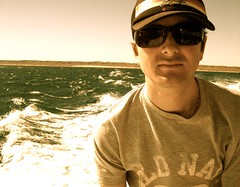
I have recently changed my blog template. It's part template and part me playing around with HTML/CSS or whatever the code is. Granted it's not pretty and I won't be getting a web design job anytime soon, but quite a bit of thought has gone into the layout.
The thinking has mostly been about, 'what is the most effective layout for a blog?' A quick perusal of a blog template page like btemplates will show you there is no set pattern for templates, but you can have a rough estimate that there are twice as may right-hand side bars as left-hand side bars and also three column (left- and right-hand sidebars) are becoming more fashionable.
But from a usability perspective what is the best? Are there rules for blogs? If there are, I haven't been able to find them.
The general wisdom of print publishers, has traditionally been that the left side of the page is more inspirational/pictorial and the right hand side is more informational/factual and the most 'viewed' part of a publication is the right-hand side. An example of this is a QMedia rate card (PDF) for the Qantas inflight magazine where a right-hand side placement commands a 10% loading.
While some might say that more purchase decisions are made by the left side of the brain and that's why there's a load, it also stems from the traditional way (most) people read magazines, the right-hand side is the first thing you see when turning a page. So does this translate to the web?
Like their printed siblings, online newspapers do reserve the right-hand column for advertising. Have a look at these examples taken from today's editions:
It would seem that the right-hand side is the preferred place for advertising in online newspapers.
But if an online advertiser were to take a look at the F-Shaped pattern for reading online content, they might be a bit miffed to see the right-hand side of a web page is almost vacant of any eyeball viewing.
One more theory to throw into the mix is the left/right brain preference. One such test for this is the HBDI brain quadrant preference test. As seen in the above image, the left brain (therefore right side of the screen) is more anyltical, technical and organised while the right brain (therefore left side of the screen) is more imaginative, emotional and conceptual.
It would seem that the F-shaped viewing pattern and left-brain preference would be contradictory, but this might also provide a possible opportunity. Imagine a news web page that had the travel and lifestyle section on the left side of a page and the business and world news on the right side of the page. In this scenario you would read the section you want to and it would be placed on the most preferable side of the screen to elicit the best response.
In the end with my new blog layout I went middle of the road. I have centralised the main content but by placing my side-bar on the left I have skewed the text to the right so the informational/factual aspects of the content are brought to the fore.
Yes my blog is about marketing and advertising and more right-brain ideas, but I want to explore the technical aspects behind the execution, and that is why I prefer to have my text slightly to the right!

1 comment:
Nice informative blog, useful & full of knowledge.
when using the Digital space to comunicate you have a very short time to make an impression and create an understanding of your offer. A matter of fact studies shows that you only have 6.3sec before they leave your page.
It is crucial for your customers to understand that they are getting a service or product that has a unique value/selling proposition . I provides you below a simple way to build it and start e-transforming your busines
More from
Didier Grossemy . I Visit for Didier Grossemy Blog .
I Here For Didier Grossemy - Linkedin
Didier Grossemy Ecademy
Post a Comment